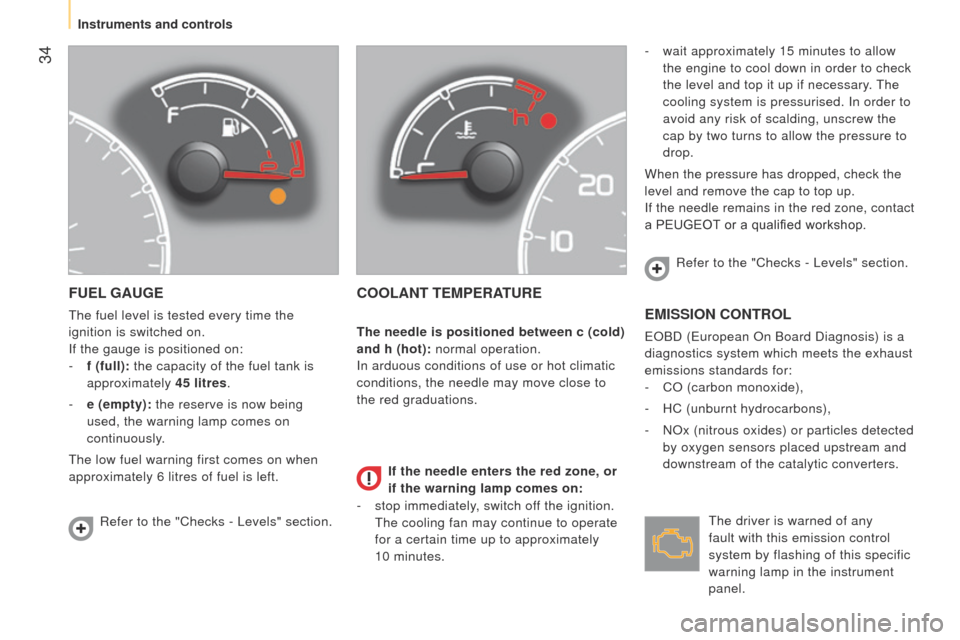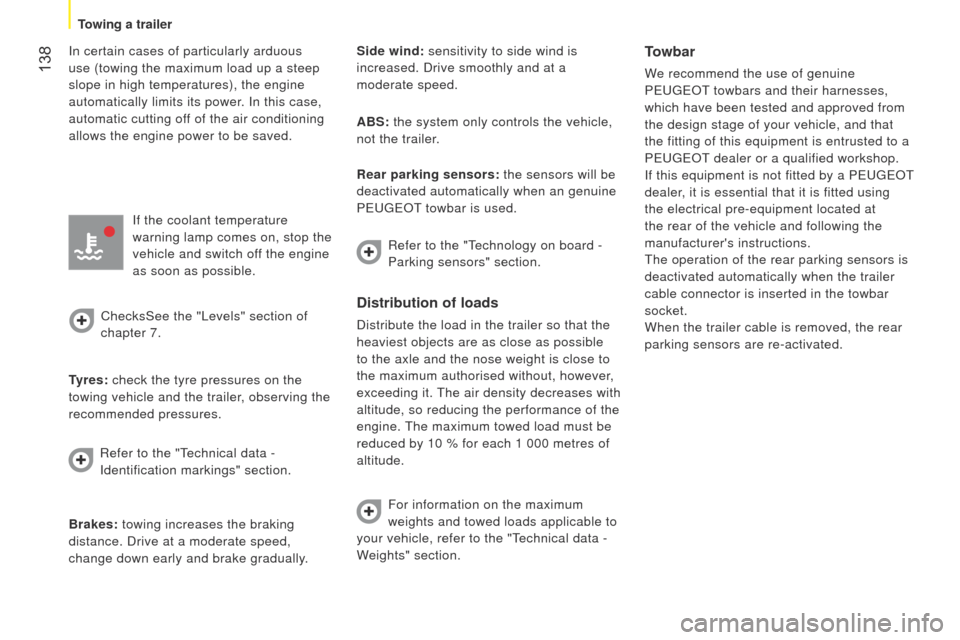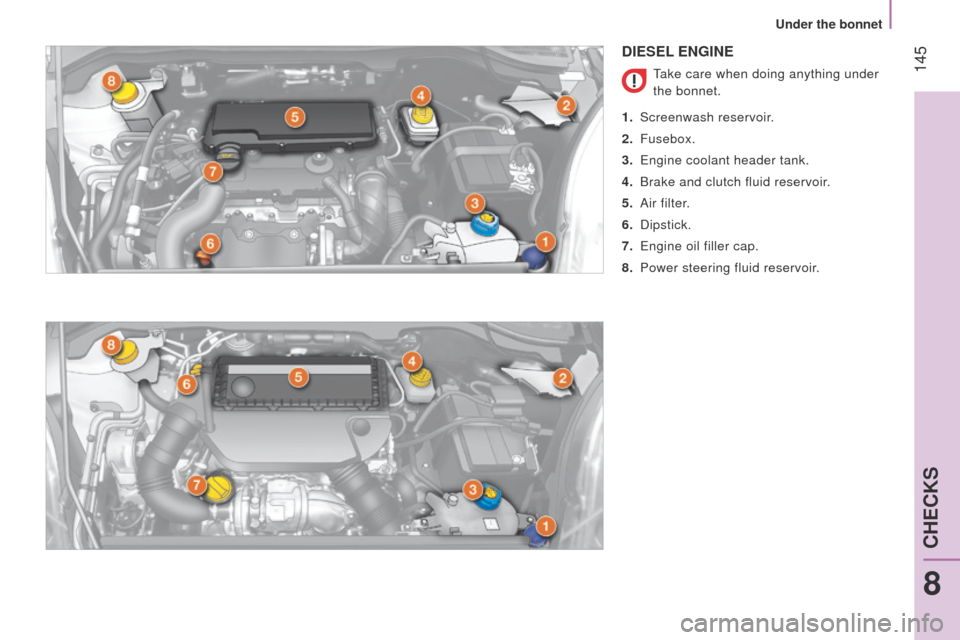2014.5 Peugeot Bipper coolant
[x] Cancel search: coolantPage 4 of 192

2
Bipper_en_Chap00a_sommaire_ed02-2014
EASE OF USE and
COMFORT
4. 64-82 SAFETY
6.
111-136
Front seats 64
Folding front passenger seat
66
Rear bench seat
67
Demisting and defrosting
71
Air conditioning
73
Front fittings
76
Load space fittings
78
Rear fittings
80
Interior lighting - courtesy lamps
82
e
xterior
4
Interior
6
Instruments and controls
12
technical data - Maintenance
16
Dashboard and centre
console
18
OVERVIEW
1.
4-21
Parking brake 1 11
Hazard warning lamps
111
Horn
112
Braking assistance systems
112
trajectory control systems
113
Tyre under-inflation detection
1
16
Seat belts
1
18
Airbags
120
Child seats
124
Deactivating the passenger's front
airbag
127
ISOFIX mountings
134
TECHNOLOGY on
BOARD
5. 83-1
10
Trip computer 83
V ehicle configuration 84
Rear parking sensors
88
Audio equipment
89
Steering mounted controls
90
Bluetooth hands-free system
93
READY TO SET
OFF
3.
25-63
Instrument panels 25
W arning lamps 26
Fuel gauge
34
Coolant temperature
34
Indicator
35
Remote control
36
Key
38
Alarm
40
Opening
41
Closing
44l
ighting stalk
46
Wiper stalk
48
Cruise control
49
Fixed speed limiter
50
Mirrors
51
e
lectric windows
52
Steering wheel adjustment
53
Manual gearbox
53e
lectronic gearbox
54
Gear shift indicator
58
Starting and stopping
59
Hill start assist
60
Stop & Start
61
ECO-DRIVING
2.
22-24
environment 22e
co-driving 23
Contents
Page 18 of 192

16
Bipper_en_Chap01_vue-ensemble_ed02-2014
emission controls ....................34, 151
Bulbs, lighting, changing
bulbs
.......
.............................
161-165
Opening the bonnet
....................... 144
u
nder the bonnet
....................
145-146
Identification markings, serial number, paint, tyres
.......
........................... 183 Changing a wiper blade
.................
166
e
ngine technical data
.............180-181
Dimensions
............................ 174-175,
176-177. 178-179
Weights
.......................................... 182
TECHNICAL DATA - MAINTENANCE
levels .....................................147-14 8
●
dipstick,
●
power steering fluid,
●
brake fluid,
●
coolant,
●
screenw
ash.
Checks.................................... 149-151
●
battery
,
●
air/passenger compartment filter
,
●
oil filter
,
●
particle emissions filter (1.3 HDi 75),
●
parking brake,
●
brake pads.
e
ngine fuses
...................167, 170-171
Location
Page 27 of 192

25
Bipper_en_Chap03_pret-a-partir_ed02-2014
INSTRUMENT PANELS
1. Distance recorder in miles / kilometres.
2. Screen.
3.
Fuel gauge.
4.
Coolant temperature.
5.
Rev counter
.
Instrument panel with level 1 screen Instrument panel with level 2 screen
Instrument panel level 1 screen
- time.
-
Miles / Kilometres travelled.
-
t
rip computer (range, fuel consumption,
average speed).
-
Headlamp beam height.
-
Programmable overspeed warning.
-
g ear shift indicator.
-
Stop & Start.
-
Activation/ Deactivation of the
passenger's front airbag.
Instrument panel level 2 screen
- time.
-
Date.
-
Radio. -
Miles / Kilometres travelled.
-
Modes and gear engaged on the
electronic gearbox,
- t
rip computer (ambient temperature,
range, fuel consumption, average speed
-
Headlamp beam height,
-
Programmable overspeed warning,
-
Selection of the display language,
-
g ear shift indicator.
-
Stop & Start.
-
Activation/ Deactivation of the
passenger's front airbag.
- State and alert messages for vehicle
functions.
3
READY TO SET OFF
Instruments and controls
Page 28 of 192

26
Bipper_en_Chap03_pret-a-partir_ed02-2014
WARNING LAMPS
every time the engine is started: a series of warning lamps comes on appl\
ying a self-checking test.
t
hey go off almost immediately. When the engine is running: the warning lamp becomes a warning sign if\
it remains on continuously or
flashes.
t
his initial warning may be accompanied by an audible signal and a messag\
e in the screen. "Do not ignore these warnings."
Warning lampis indicates Solution - action
Service on temporarily. minor faults.
Contact a P
euge O t
dealer or a qualified
workshop.
continuously on,
accompanied by a
message in the screen. major faults. Make a note of the warning message and
contact a P
euge O t
dealer or qualified
workshop.
Parking brake
Brake fluid level on.
that the parking brake is applied or
has not been released correctly.Releasing the parking brake switches off the
warning lamp.
on. that the fluid level is too
low.
top up using a fluid recommended by
P
euge O t
dealers.
continuously on, even
though the level is
correct. Stop as soon as it is safe to do so. Park,
switch off the ignition and contact a
PEUGEOT dealer or qualified workshop.
l
ow engine oil level on.
that the level of oil in the
engine is too low. Check the engine oil level and contact a
P
euge O t
dealer or a qualified workshop.
continuously on, even
though the level is
correct. Stop as soon as it is safe to do so. Park,
switch off the ignition and contact a
PEUGEOT dealer or a qualified workshop.
Coolant temperature on with the needle in
the red zone.
an abnormal increase. Park and switch off the ignition, allow the system
to cool. Visually check the level.
on H in the red zone. the coolant temperature is
too high. "Checks -
l evels" section.
Contact a P
euge O t
dealer or a qualified
workshop.
Instruments and controls
Page 36 of 192

34
Bipper_en_Chap03_pret-a-partir_ed02-2014
FUEL GAUGE
the fuel level is tested every time the
ignition is switched on.
If the gauge is positioned on:
-
f (full):
the capacity of the fuel tank is
approximately 45 litres.
-
e (empty):
the reserve is now being
used, the warning lamp comes on
continuously.
t
he low fuel warning first comes on when
approximately 6 litres of fuel is left.
COOLANT TEMPERATURE
- wait approximately 15 minutes to allow
the engine to cool down in order to check
the level and top it up if necessary.
t
he
cooling system is pressurised. In order to
avoid any risk of scalding, unscrew the
cap by two turns to allow the pressure to
drop.
When the pressure has dropped, check the
level and remove the cap to top up.
If the needle remains in the red zone, contact
a PEUGEOT or a qualified workshop.
EMISSION CONTROL
eOBD (european On Board Diagnosis) is a
diagnostics system which meets the exhaust
emissions standards for:
-
CO (carbon monoxide),
-
HC (unburnt hydrocarbons),
-
NOx (nitrous oxides) or particles detected
by oxygen sensors placed upstream and
downstream of the catalytic converters.
Refer to the "Checks -
l
evels" section. Refer to the "Checks -
l evels" section.
t
he driver is warned of any
fault with this emission control
system by flashing of this specific
warning lamp in the instrument
panel.
If the needle enters the red zone, or
if the warning lamp comes on:
The needle is positioned between c (cold)
and h (hot): normal operation.
In arduous conditions of use or hot climatic
conditions, the needle may move close to
the red graduations.
-
stop immediately
, switch off the ignition.
t
he cooling fan may continue to operate
for a certain time up to approximately
10
minutes.
Instruments and controls
Page 139 of 192

137
Bipper_en_Chap07_accessoire_ed02-2014
TOWING A TRAILER, CARAVAN, ETC...
Driving advice
As the fan is electrically controlled, its
cooling capacity is not dependent on the
engine speed.
On the contrary, use a high gear to lower the
engine speed and reduce your speed.In all cases, pay attention to the coolant
temperature.
A towed vehicle must free wheel: gearbox in
neutral.
Cooling: towing a trailer on a slope
increases the coolant temperature.
7
ACCESSORIES
Towing a trailer
Page 140 of 192

138
Bipper_en_Chap07_accessoire_ed02-2014
In certain cases of particularly arduous
use (towing the maximum load up a steep
slope in high temperatures), the engine
automatically limits its power. In this case,
automatic cutting off of the air conditioning
allows the engine power to be saved.If the coolant temperature
warning lamp comes on, stop the
vehicle and switch off the engine
as soon as possible.
ChecksSee the "
l evels" section of
chapter 7.
Tyres: check the tyre pressures on the
towing vehicle and the trailer, observing the
recommended pressures.
Brakes: towing increases the braking
distance. Drive at a moderate speed,
change down early and brake gradually. Side wind: sensitivity to side wind is
increased. Drive smoothly and at a
moderate speed.
ABS: the system only controls the vehicle,
not the trailer.
Distribution of loads
Distribute the load in the trailer so that the
heaviest objects are as close as possible
to the axle and the nose weight is close to
the maximum authorised without, however,
exceeding it.
t
he air density decreases with
altitude, so reducing the performance of the
engine.
t
he maximum towed load must be
reduced by 10 % for each 1 000 metres of
altitude.
Refer to the "
t
echnical data -
Identification markings" section. Rear parking sensors: the sensors will be
deactivated automatically when an genuine
P
euge O t towbar is used.
Towbar
We recommend the use of genuine
P
euge O t towbars and their harnesses,
which have been tested and approved from
the design stage of your vehicle, and that
the fitting of this equipment is entrusted to a
P
euge O t
dealer or a qualified workshop.
If this equipment is not fitted by a P
euge O t
dealer
, it is essential that it is fitted using
the electrical pre-equipment located at
the rear of the vehicle and following the
manufacturer's instructions.
t
he operation of the rear parking sensors is
deactivated automatically when the trailer
cable connector is inserted in the towbar
socket.
When the trailer cable is removed, the rear
parking sensors are re-activated.
Refer to the "
t
echnology on board -
Parking sensors" section.
For information on the maximum
weights and towed loads applicable to
your vehicle, refer to the "
t
echnical data -
Weights" section.
Towing a trailer
Page 147 of 192

145
Bipper_en_Chap08_verifications_ed02-2014
DIESEL ENGINE
take care when doing anything under
the bonnet.
1.
Screenwash reservoir
.
2.
Fusebox.
3.
e
ngine coolant header tank.
4.
Brake and clutch fluid reservoir
.
5.
Air filter
.
6.
Dipstick.
7.
e
ngine oil filler cap.
8.
Power steering fluid reservoir
.
8
CHECKS
Under the bonnet